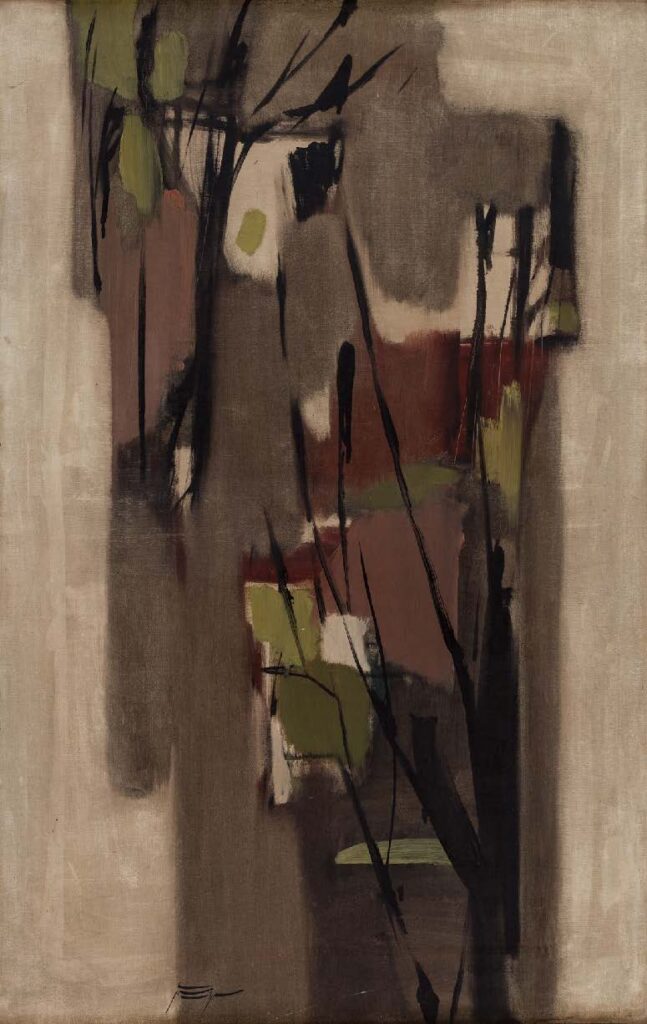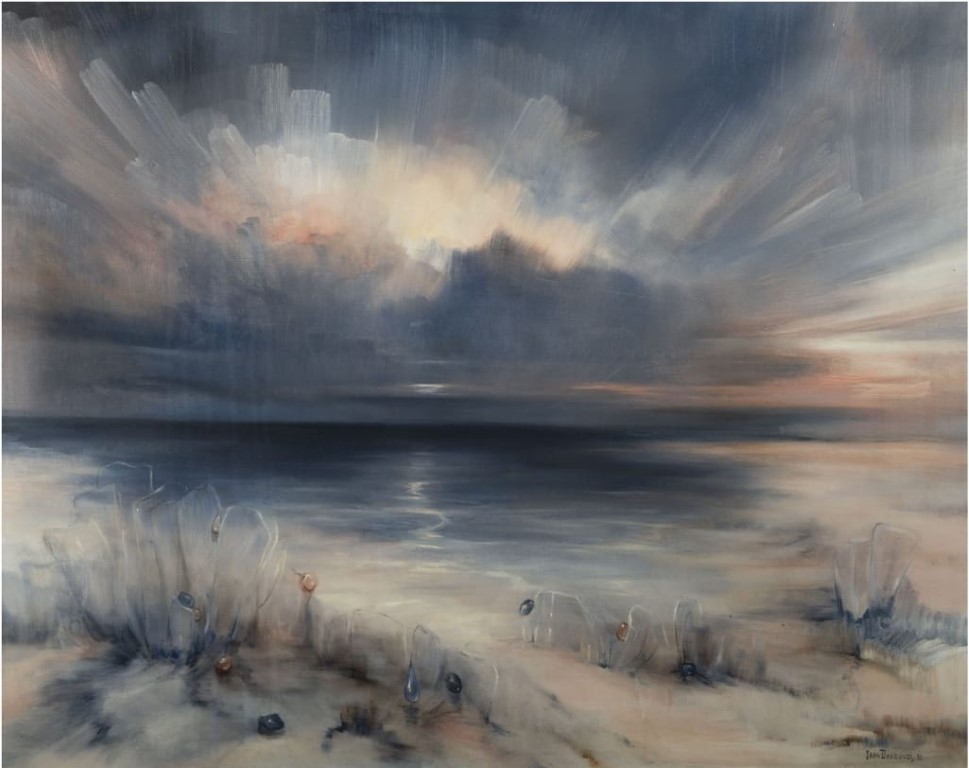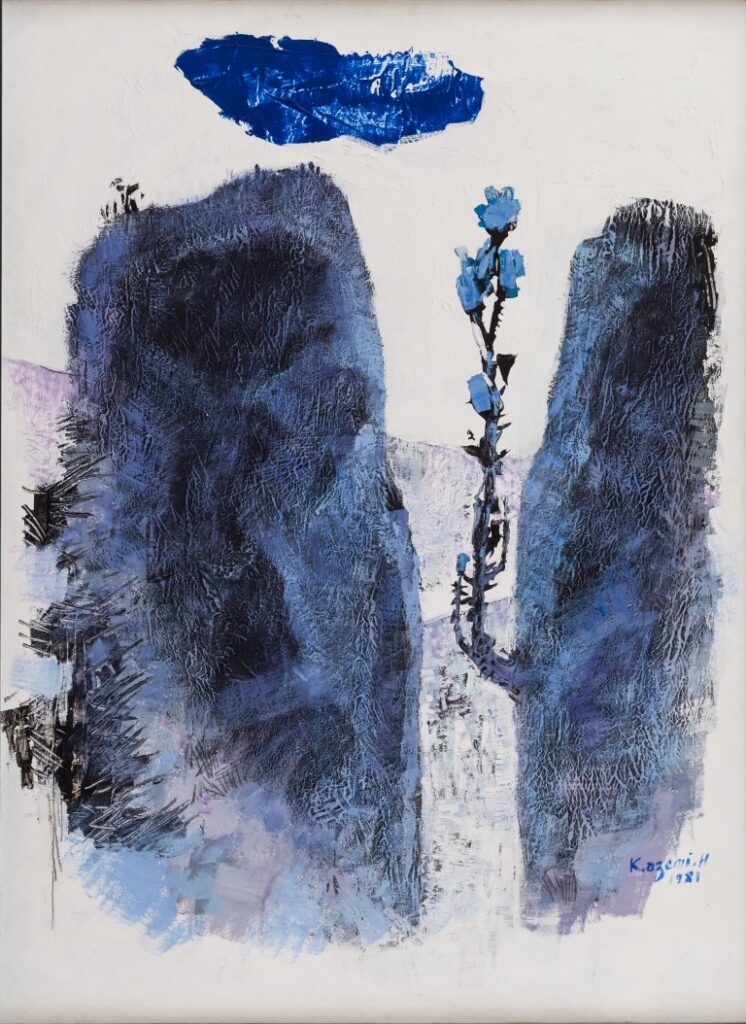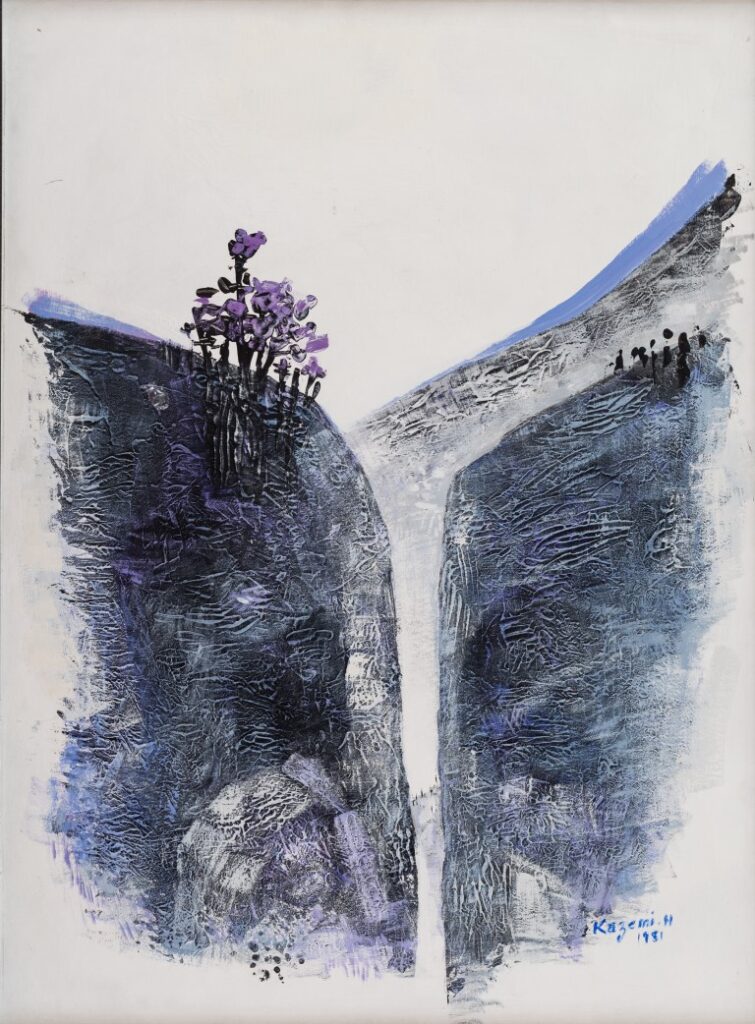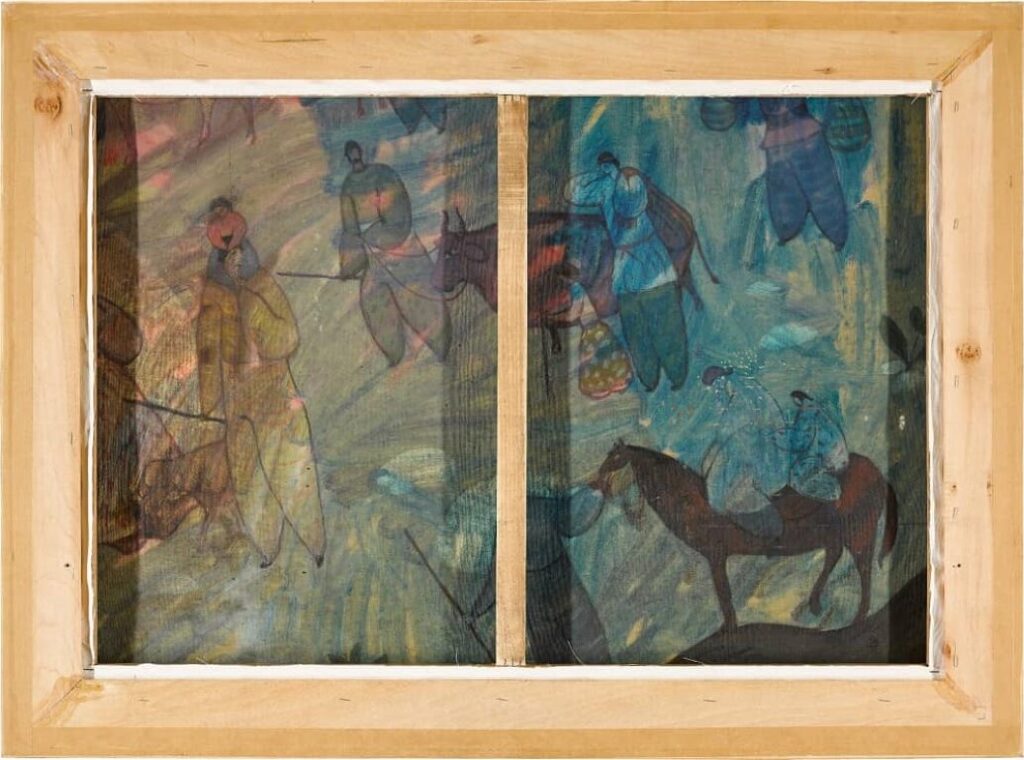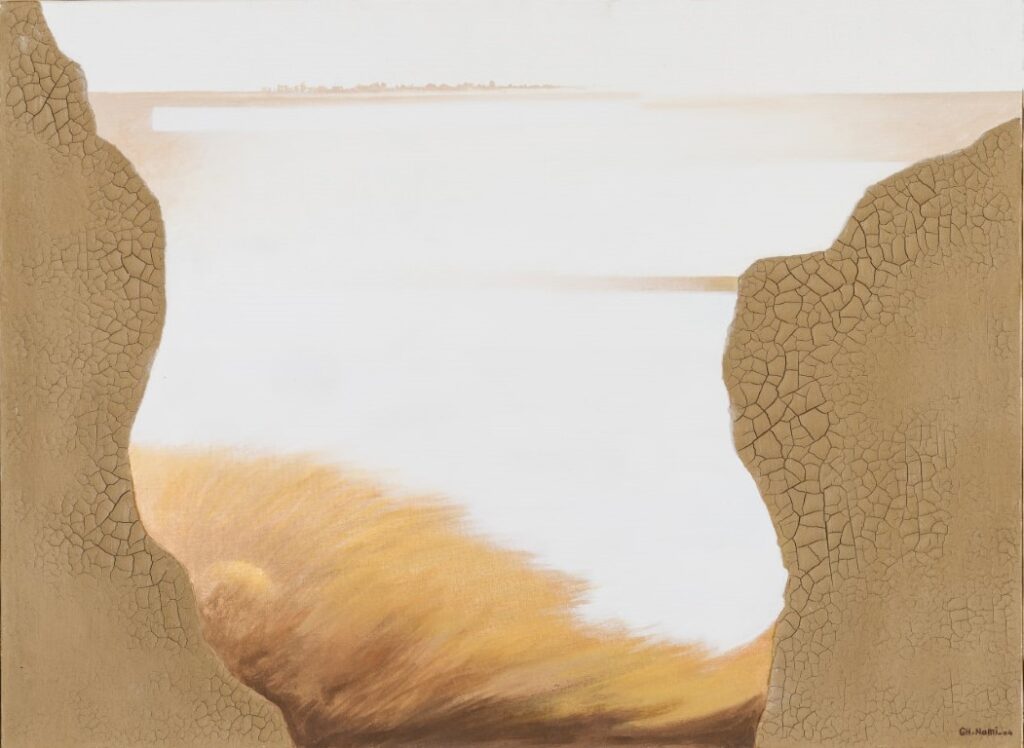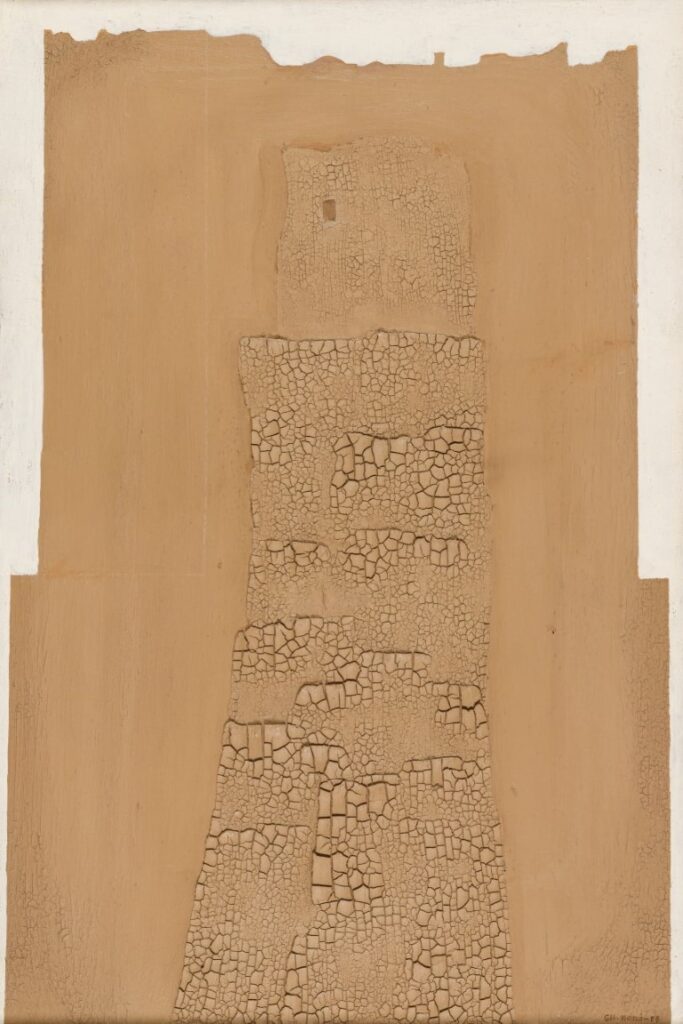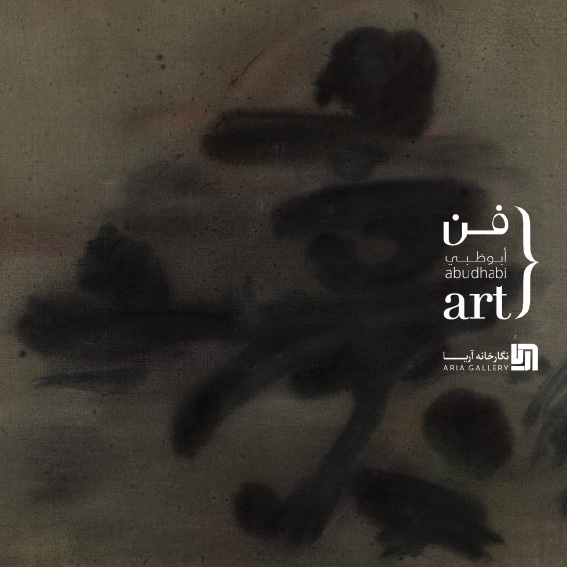
Since its establishment in 1992, Aria Galley’s main focus has been on painting and sculpture, introducing artists and exhibiting artworks with a Modernist approach. The gallery organized a project called Reinterpreting Iranian Modern Art. With the project, the gallery tries to introduce progressive, influential artists in the Iranian art scene, through exhibitions, publications, interviews, and reviews featuring their artistic process and developments.
Aria Gallery for its first participation in 14th edition of Abu Dhabi Art is proudly presenting a collection of works by a number of pioneers of Iranian Modernist art with the theme of landscape painting. Since the first attempts of Iranian artists in the 1930s to revolutionize Persian painting through the tricks of Naturalism, to their closer acquisition with Modern art schools through education in the West in the 1940s and on, landscape painting has always remained at the center of attention and interest of Iranian Modernists. Through the rejection of forms of official art of previous eras, these artists found their desired paradigms in the works of Russian Realists and French Impressionists, and the most eagers among them turned to Cezanne and Van Gogh. With the development of Iranian Modernist movement, artists paid attention to Cubism and Expressionism. Throughout all these eras, landscape painting, as a popular genre among artists, has served as a resort for the creation of invaluable and everlasting works in the history of Iran’s Modern art.
So Aria gallery presents artworks with the theme of landscape painting by
Sohrab Sepehri (1928-1980), Manouchehr Yektai (1921-2019), Hossein Kazemi (1924-1996), Bahjat Sadr Mahallati (1924-2009), Naser Assar (1928-2011), Mansour Qhandriz (1935-1965), Iran Darroudi (1936-2021) and Gholam’Hossein Nami (b.1936), … so as to reflect a part of achievements of a number of those pioneers.
Hamidreza Karami
Sohrab Sepehri
(1927-1980)
Sohrab Sepehri, Iranian poet and painter, gained considerable prestige in the Iranian art and literature for his artistic mysticism as well as his innovations in deploying both eastern and western aesthetic achievements in his works. He worked as a teacher for a while in Kashan, from which he quit and moved to Tehran to work on the painting and poetry scene. He entered the Faculty of Fine Arts at the University of Tehran (1948) and later joined The Fighting Cock Society (1949). He published his first collection of poems entitled The Death of Color (1951). He went to Paris to pursue his studies in art (1957). He participated in first Biennial of Tehran. After he returned to Tehran and partook in the second Biennale of Tehran, he went to Japan to study Far Eastern art (1960). His exhibition in Reza Abbasi Museum established Sepehri as a painter with a unique style (1961). He traveled to numerous cities in Europe, Asia, and North America to exhibit his works.
His watercolor and gouache paintings can be considered as the reflection of the moments of poetic experience
in the world of objects. His unhindered, rapid brush movements, the blending of colors, the emphasis on color
contrasts, and the use of concentrating factors in two-dimensional spaces (e.g. a crimson stain signifying a red tulip), are among the characteristics of this specific period of his career that show his influences of the abstract paintings of School of Paris. Nevertheless, there is a conscious attempt to merge eastern and western traditions, trying to achieve an independent, personal style. By mastering calligraphic design, exploring the value of positive space in composition, limiting his use of colors, Sepehri shows a tendency towards Zen paintings. Compressing and distilling the forms, emphasizing on the rhythm of the lines and the use of expressive stains, considering the balance between the empty and filled spaces, and making use of fluid and dilute coloring techniques, were among the methods Sepehri learned from Far-Eastern ink wash paintings. In his works, he oscillated between figuration and absolute abstraction, and between sensual approach to reality and rational organization of the images. Sometimes, he improvised with fluid lines and khaki colors; and at times he used definitive geometric shapes and bright colors. However, he often connected his diverse formal experiences by emphasizing on the principle of vacuum, retaining the essence of his unique style.
Iran Darroudi
(1936-2021)
Iran Darroudi, an Iranian painter and art writer, studied painting at Ecole Nationale Superieure des Beaux-Arts (1954-1958). Later, she took art history courses at the Ecole du Louvre in Paris (1958), stained glass at the Royal Academy of Brussels (1962) and television direction and production at the Institut RCA Institute in New York City (1966-1967). She held her first solo exhibition in Farhang Hall in Tehran (1960). Since then, she exhibited her paintings individually and in groups many times in Iran and other countries. Tehran Museum of Contemporary Arts organized an exhibition to commemorate her (2008).
Darroudi was also active in the field of writing and filmmaking. In the early 1960s, she published her art writings in Keyhan newspaper and Sokhan magazine. She made a TV series titled Identification of Art (1967-1972) and the documentary film Venice Biennale (1968) for the National Radio and Television Organization of Iran. Two books from her collection of works with the titles Iran Darroudi: Paintings 1959-1973 (1973) and The Listening Eye (2004) as well as the books Between Two Points Autobiography and The Story of Man and his sustainability (2009) has been published.
At first, she painted urban landscapes with a semi-abstract tendency, after which she became inclined towards Art Informel. From the late 1960s, “in search of recovering her cultural roots”, she turned to a kind of mental imagery: dreamlike images of frozen lands, cities in the process of destruction, or desert landscapes with the frequent presence of allegorical motifs such as Flower, root, stone, pearl, crystal and luminous horizon
Manouchehr Yektai
(1922-2019)
Manouchehr Yektai, was an Iranian-American painter and poet. His experiences in the artistic milieu of Paris and New York in the years immediately following the Second World War became manifest in his personal style. Yektai dropped out of the Faculty of Fine Arts at Tehran University and moved to the US (1944). For a short while, he studied under Amédée Ozenfant in Paris, France, and later in New York City. Afterwards, he took courses at the École des Beaux-Arts for a year. He then returned to New York and studied at the Art Students League of New York in New York City with Robert Hale. Yektai held his first solo exhibition at Borgenicht Gallery in New York (1951). In the mid-1950s, he participated in a group exhibition of abstract expressionists at Stable Gallery. Later on, he exhibited his works in several solo and group exhibitions across
the states. Yektai’s works were first shown in Iran at Zand Gallery (1970).
Yektai mainly painted still-life, landscapes, and portraits. His spontaneity and thick impastos, often applied by palette knife and trowel on vast, white surface of the canvas, are the key features of his works. Although he is influenced by action painting, he takes a great deal of interest in figurative painting. He has endeavored to fuse his abstract approach into subject-matters of everyday life. He said: “I am seeking to discover a truth that is concrete and satisfactory for me. When I create something, I really want there to be a truth that cannot be easily shaken.
I want it to be difficult to be rooted out; at least not anytime soon.” Yektai’s search for truth has also been expressed with the language of poetry. His first collection of poems was titled Falgoosh lit. “Eavesdrop”.
Naser Assar
(1928-2011)
Naser Assar, Iranian Painter, received a bachelor’s degree in painting from the Faculty of Fine Arts of Tehran University (1953). Assar went to France and studied at one of the atelier libre in Paris (1953-1955). He held his first solo exhibition at Parishem Gallery in Paris (1955). After that, he exhibited his works in solo and group exhibitions in Paris, Athens, London and other European cities. His only solo exhibition was held in Tehran at Litho Gallery (1966). His different periods of painting were introduced in Christopher Guyart Gallery (2009). Except for a one-year stay in England (1966-1967), and then a short trip to Iran, he lived and worked in Paris. Among the prominent features of his paintings, we should mention the calligraphic brushwork, limited color palette, and balanced empty and filled spaces. For this reason, Assar is known in France as an artist influenced by the tradition of Zen Buddhism painting. Probably, the orientalism of many artists of the Paris School influenced his tendency towards Chinese art.
Hossein Kazemi
(1924-1996)
Hossein Kazemi, an Iranian painter, potter and lecturer, is one of the pioneers of the modernism movement in Iran, and is considered one of the artists who turned to Western modernism based on Eastern vision. He completed his bachelor’s degree in painting at the University of Tehran Fine Arts Faculty. In the same year, he participated in the Fine Arts Exhibition of Iran (by the efforts of the Association of Cultural Relations between Iran and the Soviet Union) with several works. He continued his artistic activity seriously. With the cooperation of his friends, he founded the Apadana Gallery and exhibited a new collection of his paintings there (1950).
He went to France to continue his studies. During his long stay in Paris, he introduced his works. After returning to Iran, he exhibited his works in Reza Abbasi Hall (1960). At the same time, he started experimenting with pottery. In the following years, he participated in Tehran and Venice Biennales, and several other group exhibitions inside and outside the country. For several years, he was the director of Fine Arts Schools in Tabriz and Tehran (1967-1958). Until immigrating to France (1980), he was teaching at the Tehran Academy of Decorative Arts and was the head of this school for a while.
In Kazemi’s early works, two different tendencies can be clearly distinguished: realism in the manner of the impressionists, and a kind of poetic imagery influenced by the Isfahan school of Persian painting. Gradually, the second tendency prevailed in his work and was revealed in the form of exaggerated use of curved lines. His efforts to represent the ideal in a new way finally yielded a more favorable result in a series of gouache paintings. Now he used to shape the figures with the help of continuous curved lines, and made the lines subject to a background which itself consisted of tangled color spots. The next development in Kazemi’s work was the approach to pure abstraction. In one period, he created large-scale compositions with fast and harmonious strokes of the brush. In the next step, he managed to establish a balanced harmony between the stillness of right-angled shapes and the dynamism of calligraphic lines. The theme of confrontation and unity of opposite elements was more clearly expressed in his late semi-abstract paintings.
Mansour Ghandriz
(1935-1965)
Mansour Qhandriz, Iranian painter, was one of the most talented contemporary artists who could not continue his work due to his sudden death in a car accident. He was born in Tabriz and studied at the Tehran Fine Arts School of the boys. He spent two fruitful years in Tabriz (1958-1960). For the first time, he exhibited a series of his paintings in Reza Abbasi Hall in Tehran (1960). He started his bachelor’s degree in Tehran Academy of Decorative Arts. With the cooperation of several other painters, he founded the Hall of Iran later Qhandriz Hall. He participated in the third (1962) and fourth (1964) Tehran Biennale and several other exhibitions inside and outside the country.
Qhandriz quickly passed the stage of academic experimentation and imitating the styles of Impressionism and Post-Impressionism. In paintings such as Horses (1959), he was influenced by old Chinese painting, and this was the transition stage to a personal style that happened during his stay in Tabriz, influenced by Matisse and Persian painting. Bright and flat color surfaces, soft shape-forming lines, and tall figures with small heads and simple and rough village clothes are the distinctive features of his works in this period. Gradually, a mythological approach and old mysterious themes were found in his works, although his painting tended to be more formal and simple.
Staying in Tehran, studying at the Academy of Decorative Arts, the atmosphere of the Biennales, and the tendency of a number of artists towards the decorative and abstract style – which was called Saqqa-khana school – led Qhandriz to a new direction. After that, creating shapes became important in his work and the primitive character of his painting became more obvious. In the first works, the semi-abstract shapes of man, bird, sun, sword and shield, in combination with repeating geometric patterns, have filled the limited space of the compositions. Gradually, figurative elements give way to simpler and more explicit geometric forms, however, his painting rarely reaches the border of absolute abstraction. Qhandriz always emphasized the presence of a spiritual quality in his art – based on the aesthetic values of the Iranian pictorial tradition – and perhaps it was this sensitivity that prevented him from pure formalism.
Behjat Sadr Mahallati
(1924-2009)
Behjat Sadr, Iranian painter and lecturer, was one of the pioneers of abstract painting in Iran. She received a bachelor’s degree in painting from the Faculty of Fine Arts of Tehran University (1948-1954). Receiving a scholarship, she went to Italy and studied (1956), first at the Roberto Melli Academy, and then at the Academy of Fine Arts in Naples. She held her first solo exhibition in Pincho Gallery in Rome (1957) and after participating in several group exhibitions, she returned to Iran (1959). She started teaching at the Faculty of Fine Arts of Tehran University (1960-1980) and for a period of time she managed the visual arts department of this faculty (1968-1971). She went to France for a short stay (1980), but due to a serious illness, she stayed in Paris for treatment. From then until the end of her life, she traveled between Paris and Tehran and finally died in France.
Behjat Sadr exhibited her works many times in solo and group exhibitions in Iran, Italy, United States, France and other countries and succeeded in receiving awards, including the Grand Prize of the 3rd Tehran Biennale (1962) and the UNESCO Prize in art competition “Fighting Illiteracy” (1967). The Tehran Museum of Contemporary Arts introduced different periods of her work in the “Pioneers of Iran’s Modern Art” exhibition series (2004) and published a book on this occasion.
Sadr created her first abstract works in the years of Art Informel popularity in Europe. She put the canvas on the floor and do her work through a process of pouring paint and quickly removing paint with a painting knife. In this way, intricate shapes and signs emerged from the colored background, representing the expressive movements of the painter’s hand. She used this method in her later paintings with greater mastery and skill on aluminum and wooden support and created balanced and harmonious compositions with wavy lines and strips. The Kinetic Art experience with painted shutters (1967) and the series of photo/painting collages (1981-2001) were among her other attempts to align with the developments in the art world. She said once in an interview (2008): “I think it is very important for an artist to live in real time and be contemporary with the world around him.”
Gholam’Hossein Nami
(b. 1936)
Gholam’Hossein Nami, an Iranian painter, lecturer and art writer, is an experimental artist who always examines matter and form in a precise geometry. He completed a bachelor’s degree in painting at the Faculty of Fine Arts of Tehran University (1957-1963). Later, he received a master’s degree from the University of Wisconsin-Milwaukee in the United States (1980). He held his first solo exhibition in Seyhoun Gallery (1967). He has exhibited his works individually and as a group many times in Iran, the United States, France, Canada and other countries, and has received numerous awards, including in the Mother’s Day exhibition (1966), the World Human Rights Day exhibition (1968) and the international painting festival of Cagnes-sur-Mer in France (1970).
He actively participated in the formation of the Azad Group and its exhibitions (1974-1976). His books “Drawing with pen and ink” (1985) and “Gholam’Hossein Nami, selected works of 1961-1993” (1996) have been published. His activities included teaching at the Fine Arts Schools for boys and girls in Tehran, Science and Technology University, Islamic Azad University and other educational centers.
Nami has touched various experiences in his painting, experiences that often progressed parallel to each other. He himself says about this: “All the time I was making three-dimensional white abstract works, I was busy making landscapes, colorful compositions with rich colors, and creating nature… all the time I was working with volumes. I took the motivations from nature, but nature was crystallized in my mind, changed, stylized, and became abstract and turned to symbolic forms”. He shows another aspect of nature in his abstract compositions with cracked clay surfaces.



